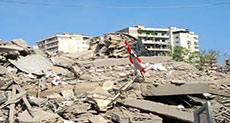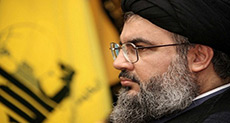
Is “Israel” to give in to the deterrent-resistance reality?

Assafir" Newspaper
By Ali Dreije
"The ‘Israeli' soldier fights on the battlefront while the farmer (settler) plows the land in peace and tranquility."
A few words sum up the "Israeli" army combat doctrine, which has for the past decades provided a protection umbrella for ‘Israel's' interior during its wars against the Arabs, until the ‘Second Lebanon War' came in July 2006 to debilitate its foundation, blow up its fragile structure and rewrite its text to what now appears thusly:
The soldier fights on the battlefield, the "Israeli" farmer abandons the land in search of protection away from the threat of death, seeking refuge in safe and secure rooms, while danger looms from every which direction... the resistance has punctured large major in this large umbrella, a heavy rain of rockets is leaking down on "Israeli" settlements, towns and cities in thirty three days of war.
For the first time in the history of the Arab-"Israeli" conflict, the Zionist entity's interior is breached, settlers exposed to death and destruction just like those the war is waged against, provoking a violent shock in the "Israeli" community and military institution alike, a shock which continues to resonate until today.
Blitzkrieg
"Israel's" traditional war strategy- ‘blitzkrieg'- adopted by the "Israeli" army in all its wars against Arabs is based on the following details:
First: Pre-emptive war and achieving the element of surprise.
Second: A speedy conclusion through excessive use of force and accuracy of planning.
Third: Take the fight to the adversary, keep "Israel's" interior away from the conflict.
Fourth: Dependence on air, technical and informational superiority.
Fifth: A rapid tank advance after destroying most of the opponent's power through aerial and artillery bombardment, to install victory, occupy the land and liquidate remaining pockets of resistance.
The success of this strategy in each of Iraq, Afghanistan and Yugoslavia, prompted "Israel" to adopt it in its confrontation with Hizbullah in July 2006. Technical features developed in the recent two decades were taken advantage of in the military field, they include the following elements:
Absolute air control, surveillance accuracy, round the clock target setting and accuracy, apart from an enormous destructive power of concentrated aerial bombardment, to the use of smart bombs, modern high-tech missiles (including the use of depleted uranium sometimes) on military sites and infrastructure of the resistance, mainly command posts to cut off combatants causing them to wander blindly after loss of communication with their commanders.
The task of "Israeli" helicopter-backed ground forces is confined to liquidating remaining pockets of resistance, to impose a military and political reality south of the Litani River according to the war's objectives.
Its failure
In July, the enemy was forced by the resistance to abandon blitzkrieg, the theory responsible for its victories against the Arabs over forty years until July 2006, when, it came face-to-face with the most violent resistance on most advance points in South Lebanon:
First: "Israel" failed to implement the lightning attack tactic.
Tanks and troops were forced to retreat; their inrush surge was reined in preventing their forces from occupying any village or city, and inflicting them with heavy losses on both human and morale levels.
Second: The "Israeli" army failed to keep their interior outside the conflict circle away from the resistance's rocket-range, which kept falling by the hundreds throughout the days of the war.
Third: The "Israeli" army failed to occupy large areas of land to establish a strategic depth as a buffer zone distant from its borders, to protect their interior from the danger of missiles. This was a major objective in the July war, when the enemy tried hard to establish a military buffer zone reaching all the way up to the borders of Sidon city.
Tactics that had previously won the enemy wars were now rendered useless by the mode of fighting the resistance adopted, prompting the enemy to work on changing warfare doctrine and distribute their capabilities on researching new appropriate methods of engagement, based on simple nontraditional technologies, a change that will lead to the transfer of the "Israeli" army from ‘recovery-room' to clinical death, as it places "Israel" in front of two bitter choices:
- To either accept the resistance as a deterrent non-touchable force in the foreseeable future
- Or go into a new adventure whose results are unknown.
"Israel" is likely to take the second option, especially since sensing after the July war, that its ‘Shield' and ‘Spear' theories upon which it based its previous wars are now in danger, hence its strategic security.
The Shield represents the central defense point of the Zionist entity; it includes forward settlements and military positions, highly developed espionage, sensory and communication systems, as well as patrols and mine fields.
The Shield's task is to absorb the shock of any future war, based on the following rule: defense is circumstantial, attack is principal and battle in enemy territory.
Accordingly, if the spear represents the "Israeli" army's air and ground forces, the armored corps in particular- shield of this entity's ‘Shield', does "Israel" have the courage to hurl eight military divisions in the coming war against the resistance in southern Lebanon, when it is well aware that this ‘Spear' may incur defeat and collapse, which will consequently leave "Israel" with only that weak shield, an archipelago of remaining settlements, vis-à-vis the new confrontation phase moved by Hizbullah leadership from possession tens of thousands of rockets- the ability to shoot from a distance- to a new phase of tens of thousands of prepared men eager to break this ‘Spear' and breach that rotting ‘Shield.'
The new military doctrine
Strategy analysts see "Israel" now facing a dilemma due to this adopted combination in the resistance's military and tactical performance, a combination of complex traditional army tactics and lethal invisibility of its guerrilla men; a rare model to all military schools of the world.
From here we can simply say previous classifications of "Guerrilla warfare" and traditional response tactics do not apply to this rare model, a fact which prompted a U.S. journalist to describe Hizbullah's military combat performance in "New York Times" magazine as: "Twenty-first century combat, new classifications brought into play in this combat-engagement include ‘War of the networks' and ‘Fourth generation war'."
In a lecture entitled "War of the Networks" 101 (The Gangs), defense analyst professor at the U.S. Naval Academy "John Arkela" saw the networks war as a battle of ‘organised preparation' in small units, against conventional armies of large numbers of troops. While these networks work on mobilizing themselves in a horizontal structure, they disperse and move about in improvised organisation according to battlefield requirements, which renders them effective in battle and difficult to track and target.
This performance brought the "Israeli" army to a stand-still dilemma, suffering on one hand from a limited range of available choices, narrowed by acute positioning which held it back from surging forward and from adopting a parallel tactic to guerrilla warfare, for fear of the potentially exorbitant within such an option.
The enemy is unable to occupy any area without large formations of troops in the field, an objective requiring total destruction of the target first, with the resistance being an invisible target, its destruction not confirmed or accomplished, the only remaining choice is for troops to be kept in the battlefield, which is what the resistance is waiting for, to break this Spear.
On the other hand, the enemy cannot remain prisoner to its old blitzkrieg-based choices.
From this standpoint "Israel" realizes that should its army engage in classic guerrilla warfare it will draw classic guerrilla war, a situation more complex and holds greater risks for the "Israeli" army, not to mention the element of morale where the "Israeli" soldier still lacks bravery, courage in combat and boldness, an issue completely reversed among resistance combatants.
Morale is gambled on by leaderships on both sides. Initial hours and days, the critical and decisive factor at morale level, have become the focus of enemy army leaders, officers and soldiers. Meanwhile an American observer describes today's "Israeli" soldier as follows: "He appears lumpy, lacking in morale, unwilling to sacrifice, he is not the soldier we once knew."
By Ali Dreije



